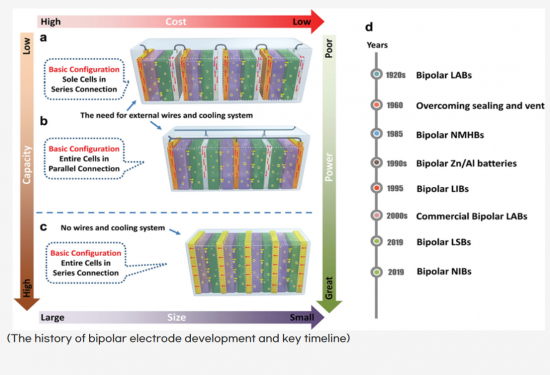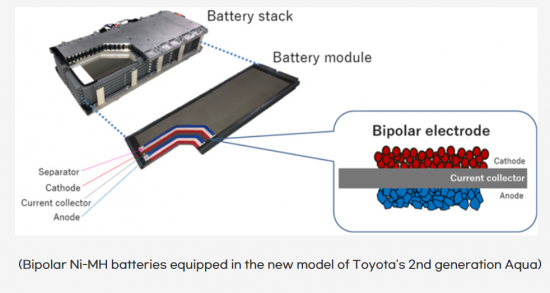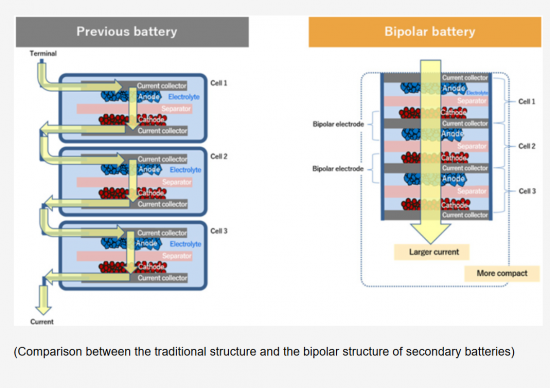 |
市场调查报告书
商品编码
1458501
双极电池技术发展现况及未来展望(2024年)<2024> Current Status and Future Outlook of Bipolar Battery Technology Development |
||||||
单电池二次电池由单极电极组成,集流体的两侧均由相同的电极材料製成,所有电极浸入相同的电解液中。由于每个电极均使用外部连接线并联连接,因此电池系统包含大量惰性材料。结果,估计体积能量密度将损失约40%,重量能量密度将损失约20%。
双极电池具有简单的电池结构和形状,因为它们不使用电连接器或其他配件。电池的体积接近各个单元电池的堆迭厚度乘以单元电池基板面积的总和,电池的重量相当于所有组件的总质量。双极电池的容量等于单一单元电池的容量,但双极电池的输出电压由串联单元电池的数量乘以每个单元的电压决定。
在电池中使用双极电极显着提高了体积和重量能量密度。此外,基于以应用为中心的设计,可以轻鬆调整电池形状,以最大限度地利用目标装置中的电池储存空间。换句话说,透过减少电池体积和最小化BMS,可以透过最小化电池封装材料的使用来同时追求提高能量密度和降低成本。这最终可能促使电动车在有限的电池空间中安装更多电池,从而延长行驶里程。因此,双极性电极的这些优点对于行动电子设备和电动车中使用的二次电池的设计非常有吸引力。
双极电极的另一个优点是电子电流垂直流过基板,基板的大横截面积大大改善了电流密度和电流分布。因此,透过使用双极性电极,高速充电电池可以安全地运行,不会有任何安全问题。
从Furukawa Electric的使用双极电极的小型电池开始,近年来Toyota已将双极镍氢电池商业化,并将其安装在 Aqua HEV 中。Toyota于2023年6月宣布,计划在2026年至2027年为大众市场电动车生产双极磷酸铁锂电池,并在2027年至2028年为未来电动车生产双极镍基锂离子电池。此路线图的目标是与高性能 LIB 相比,增加范围并降低成本。
最近推出的Toyota Crown Countryman和LexusRX都配备了传统镍氢电池的改良版本,称为双极镍氢电池。这与使用锂离子电池的传统趋势背道而驰,尤其是在高阶和节能车型。这一转变标誌着该公司打算逐步扩大镍氢电池在整个产品线中的使用,并代表了电池技术采用的策略性变化。
在本报告中,我们对双极电池市场进行了研究和分析,并提供了近年来开始使用的双极电极的发展趋势和研发现状的资讯。



目录
第一章 二次电池用双极性电极
- 电池结构优化需求
- 双极电极
- 双极电极的开发
- 双极电极的应用
- 双极碱性电池
- 双极锂离子电池
- 双极柱 LiB(Li-S、Na 离子)
- 课题与前景
第 2 章 双极固态电池:设计、製造、电化学
- 概述
- 双极板
- 双极固态电池的製备及电化学性能
- 结果与未来展望
第三章 双极固态电池:能量密度设计
- 概述
- 结果与讨论
第4章 双极固态电池:基于准固态电解质
- 准固态锂垢复合材料
- 双极固态LIB评估
- 双极固态LIB的SEM分析
- 结论
第 5 章 双极固态电池:基于硫化物电解质
- 概述
- 结果与讨论
- 结论
第六章 双极固态电池:多步骤印刷製造基地
- 概述
- 介绍
- 实验
- 结果与讨论
- 结论
第7章 双极固态电池:FeOx-LFBO负极的应用
- 概述
- 介绍
- 实验结果
- 结论
第 8 章 双极 LFP/LTO 电池:用于微型/轻度混合动力汽车的 LIB
- 概述
- 介绍
- 实验
- 结果与讨论
- 结论
第9章 双极镍氢电池
- 概述
- 电池设计
- 晶圆电池应用
- 油电混合车应用
- 插电式混合动力汽车的应用
- 应用于公用事业
第10章 双极高压钠离子电池
- 概述
- 介绍
- 实验与方法
- 结果
第11章 双极性全聚合物电池
- 全聚合物电池的特点
- 全聚合物电池的製作方法
- 全聚合物电池的特点
- 全聚合物电池的基本结构
- 将所有聚合物电池串联堆迭
- 双极全聚合物电池,安全性更高
- 核壳型电极材料
- APB Corporation的双极型全聚合物电池
- 全聚合物电池的未来前景
第12章 双极型铅酸电池(Furukawa Electric Co., Ltd.)
- 全球首次商业化
- 用于长期储能的ESS电池
第13章双极LIB(Fraunhofer IKTS)
- 概述
- 双极电池概念
- 湿式电极製造
- 隔板涂层
- 双极电池,堆迭
- 双极电池用捲绕箔 (SCHLENK)
第14章 双极镍氢电池(TOYOTA)
- 双极电池特性
- 新电池技术
- TOYOTA的电池创新
- TOYOTA年表
- TOYOTA製造工艺
第15章 双极电池专利
- TOYOTA:双极镍氢电池
- Hyundai Motor Company:双极固态电池
- TOYOTA:双极固态电池
- Samsung SDI:双极电极和製造
- LG Chem:双极电池
- LGES:双极锂离子电池
- KITECH:双极固态电池
- ProLogium:水平复合进料结构
参考
A single-cell secondary battery consisted of monopolar electrodes, where both sides of the current collector are composed of the same electrode material, has all electrodes immersed in the same electrolyte. Since each electrode is connected in parallel using external connecting wires, a significant amount of inactive material has been integrated into the battery system. As a result, it is estimated that the volumetric energy density may experience a loss of approximately 40%, and the gravimetric energy density approximately 20%.
The bipolar battery features a simple cell configuration and shape as it does not utilize electrical connectors or other accessories. The volume of the battery is close to the product of the total stack thickness of the individual unit cells and the substrate area of the unit cell, while the weight of the battery is comparable to the total mass of all components. Although the capacity of the bipolar battery is equivalent to that of a single unit cell, the output voltage of the bipolar battery is determined by the number of unit cells connected in series and the voltage of each cell multiplied together.
Using bipolar electrodes in batteries significantly increases both volumetric and gravimetric energy density. Additionally, based on application-centric design, the battery shape can be easily adjusted to maximize the utilization of the battery storage space in the target device. In other words, the battery volume decreases, and by minimizing the BMS, energy density enhancement and cost savings can be simultaneously pursued through minimized use of cell packaging materials. This ultimately translates into the ability to install more batteries in limited electric vehicle battery mounting spaces, potentially leading to increased driving range. Therefore, these advantages of bipolar electrodes are highly attractive for the design of secondary batteries used in mobile electronic devices and electric vehicles.
Another advantage of bipolar electrodes is that electron flow occurs vertically through the substrate, and when the substrate's cross-sectional area is large, current density and distribution are significantly improved. Therefore, using bipolar electrodes allows fast-operating secondary batteries to function safely without any safety issues.
Starting with Furukawa Electric's compact batteries featuring bipolar electrodes, Toyota has recently commercialized bipolar Ni-MH batteries, which were applied to the Aqua HEV. In the announcement at June 2023, Toyota revealed a roadmap stating that they plan to produce bipolar LFP batteries for volume-grade EVs in 2026-2027 and bipolar Ni-based LIBs for future versions of EVs in 2027-2028. This roadmap aims to enhance driving range and reduce costs compared to performance versions of LIBs.
The recently released Toyota Crown Crossover and Lexus RX feature an improved version of the traditional Ni-MH battery, known as the bipolar Ni-MH. This marks a departure from the previous trend of using LIBs, especially in high-end and fuel-efficient models. This shift suggests an intention to gradually expand the use of Ni-MH batteries across the lineup, indicating a strategic change in battery technology adoption.
In this report, we have compiled the history of the development of bipolar electrodes, which have recently begun to be applied, as well as the current status of research and development. We have detailed each development to provide a comprehensive overview, making it easy to understand the overall situation.
The strong points of this report are as follows:
- 1. ailed coverage of recent technological trends related to bipolar batteries
- 2. ailed coverage of the development history and current status of bipolar battery developers
- 3. centrated coverage of the development status of bipolar batteries at Toyota Motor Corporation
- 4. lysis of bipolar battery's key patent



Table of Contents
1. Bipolar Electrodes for Secondary Batteries
- 1.1. The Necessity of Battery Structure Optimization
- 1.2. Bipolar Electrodes
- 1.3. Development of Bipolar Electrodes
- 1.3.1. History of Bipolar Electrode Development
- 1.3.2. Reduction in Weight, Size, and Cost
- 1.3.3. Improvement in Energy Density/Power Density
- 1.3.4. Requirements and Disadvantages of Bipolar Electrodes
- 1.4. Applications of Bipolar Electrodes
- 1.4.1. Bipolar Lead-Acid Batteries (LAB)
- 1.4.2. Improvement of Bipolar Lead-Acid Batteries
- 1.4.2.1. Surface Modification
- 1.4.2.2. Corrosion Prevention
- 1.4.3. Commercialization of Bipolar Lead-Acid Batteries
- 1.5. Bipolar Alkaline Batteries
- 1.5.1. Bipolar Ni-MH
- 1.5.2. Bipolar Al and Zn Batteries
- 1.6. Bipolar Lithium-Ion Batteries
- 1.7. Bipolar post-LiB(Li-S, Na-ion)
- 1.8. Challenges and Outlook
- 1.8.1. Substrate Materials
- 1.8.2. Electrode Materials
- 1.8.3. Electrolyte Materials
- 1.8.4. Engineering Technologies
- 1.8.5. Outlook of Bipolar Electrode
- 1.8.6. Hurdles to Commercialization
- 1.8.7. Other Bipolar Batteries
- 1.8.8. Bipolar Solid-State Batteries
2. Bipolar Solid-State Batteries: Design, Fabrication, and Electrochemistry
- 2.1. Overview
- 2.1.1. Advantages of Bipolar Solid-State Batteries
- 2.1.2. Technical Challenges of Bipolar Batteries
- 2.1.3. Requirements for Bipolar Materials
- 2.2. Bipolar Plates
- 2.3. Fabrication and Electrochemical Characteristics of Bipolar Solid-State Batteries
- 2.3.1. Free standing Lamination Bipolar Solid-State Batteries
- 2.3.2. Printing Bipolar Solid-State Batteries
- 2.4. Results and Future Outlook
3. Bipolar Solid-State Batteries: Design of Energy Density
- 3.1. Overview
- 3.2. Results and Discussion
- 3.2.1. SolidPAC demo
- 3.2.2. Comparison of Bipolar Stacking and Conventional Stacking
- 3.2.3. Sensitivity Analysis
- 3.2.4. Experimental Data Analysis
4. Bipolar Solid-State Batteries: Based on Quasi-Solid Electrolytes
- 4.1. Quasi-Solid Li-Glyme complex
- 4.2. Evaluation of Bipolar Solid-State LIBs
- 4.3. SEM Analysis of Bipolar Solid-State LIBs
- 4.4. Conclusion
5. Bipolar Solid-State Batteries: Based on Sulfide Electrolytes
- 5.1. Overview
- 5.2. Results and Discussion
- 5.2.1. Manufacturing and Characteristics of Cathode Layers
- 5.2.2. Manufacturing and Characteristics of Anode Layers
- 5.2.3. Manufacturing and Characteristics of Mono cells
- 5.2.4. Characteristics of Bipolar Stacked Solid-State Batteries
- 5.2.5. Comparison of Energy Densities in Bipolar Solid-State Batteries
- 5.3. Conclusion
6. Bipolar Solid-State Batteries: Based on Multistage Printing Manufacturing
- 6.1. Overview
- 6.2. Introduction
- 6.3. Experiment
- 6.3.1. Manufacturing of SWCNT-Coated Electrode Active Material
- 6.3.2. Fabrication of Printed Bipolar LIB
- 6.4. Results and Discussion
- 6.4.1. Solid Gel Composite Electrolyte(GCE)
- 6.4.2. Fabrication and Characteristics of Printed Electrodes
- 6.4.3. GCE and Electrode Paste Control
- 6.4.4. Mechanical Flexibility and Thermal Stability
- 6.5. Conclusion
7. Bipolar Solid-State Batteries: Application of FeOx-LFBO Anode
- 7.1. Overview
- 7.2. Introduction
- 7.3. Experiment Results
- 7.3.1. Synthesis and Characteristics of FeOx-LFBO
- 7.3.2. Electrochemical Performance of FeOx-LFBO Anode
- 7.3.3. Mechanism Analysis
- 7.3.4. Electrochemical Performance of Cu-free LIB
- 7.4. Conclusion
8. Bipolar LFP/LTO Batteries: LIBs for Micro/Mild Hybrid
- 8.1. Overview
- 8.2. Introduction
- 8.3. Experiments
- 8.4. Results and Discussion
- 8.4.1. LFP, LTO
- 8.4.2. 15Wh Bipolar Battery
- 8.4.3. Safety
- 8.5. Conclusion
9. Bipolar Ni-MH Batteries
- 9.1. Overview
- 9.2. Battery Design
- 9.3. Application of Wafer Cells
- 9.4. Application in HEVs
- 9.5. Application in PHEVs
- 9.6. Application in Utility
- 9.6.1. High-Power Bipolar Batteries
- 9.6.2. High-Energy Bipolar Batteries
10. Bipolar High-Voltage Na-ion Batteries
- 10.1. Overview
- 10.2. Introduction
- 10.2.1. Monopolar 48V Battery System
- 10.2.2. Commercialization Issues of Bipolar Batteries
- 10.3. Experiment and Method
- 10.4. Results
- 10.4.1. Bipolar Batteries with Liquid Electrolytes
- 10.4.2. nS mP(Series-Parallel) Bipolar Batteries
- 10.4.3. Na-ion Bipolar Batteries with Above 5V
- 10.4.4. Custom Cell Voltage Profile Design
11. Bipolar All Polymer Batteries
- 11.1. Characteristics of All Polymer Batteries
- 11.1.1. Advantages of All Polymer Batteries
- 11.1.2. Disadvantages of All Polymer Batteries
- 11.1.3. Energy Density of All Polymer Batteries
- 11.1.4. Manufacturers of All Polymer Batteries
- 11.1.4.1. Kawasaki Heavy Industries
- 11.1.4.2. JFE Chemical
- 11.1.4.3. Teijin
- 11.1.4.4. Gunze/Sanyo Chemical Industries
- 11.2. Manufacturing Methods of All Polymer Batteries
- 11.3. Characteristics of All Polymer Batteries
- 11.3.1. Voltage Increase by Stacking
- 11.3.2. Elimination of Drying Process
- 11.3.3. Improve of Production Speed
- 11.4. Basic Structure of All Polymer Batteries
- 11.5. All Polymer Batteries Stacked in Series
- 11.6. Safety-Enhanced Bipolar All Polymer Batteries
- 11.7. Core-Shell Type Electrode Materials
- 11.8. Bipolar All Polymer Batteries by APB Corporation
- 11.9. Future Outlook of All Polymer Batteries
12. Bipolar Lead-Acid Batteries (Furukawa Electric Co., Ltd.)
- 12.1. World's First Commercialization
- 12.1.1. Structure and Challenges of Bipolar Lead-Acid Batteries
- 12.1.2. Overcoming Challenges with Metal/Polymer Materials
- 12.2. ESS Batteries for Long-Term Power Storage
13. Bipolar LIBs (Fraunhofer IKTS)
- 13.1. Overview
- 13.2. Concept of Bipolar Batteries
- 13.3. Wet Process Electrode Manufacturing
- 13.4. Separator Coating
- 13.5. Bipolar Cells and Stacks
- 13.6. Roll Clad Foil for Bipolar Battery (SCHLENK)
14. Bipolar Ni-MH Batteries (TOYOTA)
- 14.1. Characteristics of Bipolar Batteries
- 14.2. New Battery Technologies
- 14.3. Battery Innovation by TOYOTA
- 14.4. Timeline of TOYOTA
- 14.5. Manufacturing Process by TOYOTA
15. Bipolar Battery Patents
- 15.1. TOYOTA: Bipolar Ni-MH Batteries
- 15.2. Hyundai Motor Company: Bipolar Solid-State Batteries
- 15.3. TOYOTA: Bipolar Solid-State Batteries
- 15.4. Samsung SDI: Bipolar Electrodes and Manufacturing
- 15.5. LG Chem: Bipolar Batteries
- 15.6. LGES: Bipolar LIBs
- 15.7. KITECH: Bipolar Solid-State Batteries
- 15.8. ProLogium: Horizontal Composite Electric Supply Structure











